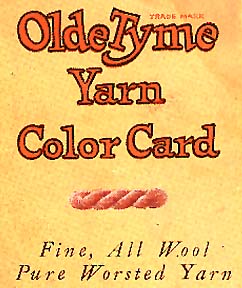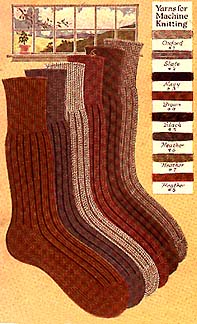

Cylinders - Yarn and Needles |
AutoKnitter, Master Machine & Gearhart
Basics
When knitters speak about "cylinder size" or "dial size" they are usually referring to the quantity of slots in the cylinder or dial. Most machines have only one diameter cylinder and dial.
The correct ribber dial has 1/2 as many slots as the cylinder. For example, the 72 slot cylinder uses a 36 slot dial. The Needle Part Names page shows the difference between dial and cylinder needles. There are some other machines that use the same needles for the cylinder and ribber.
One brand of cylinders and dials with different number of slots should fit all machines of that brand. Manufacturing variations between 1900 and the present may make this difficult to with some machines. So can damage and deterioration.
The needles, cylinder, ribber, instructions, or even other parts that come with your newly acquired old machine may not be the right ones. You cannot expect a machine that may be 50 to 100 years old to still be adjusted correctly. These factors can prevent your machine from working.
AutoKnitter machines use 12 Gauge needles, approximately 0.046 to 0.049 thick, for all cylinders and ribbers. That thickness is formally called "pressing" in the needle manufacturing business. If someone has a very old AK that requires a different pressing size needle, please let me share that information on this site.
Master Machines use the same ribber needles and cylinder needles as the AutoKnitter. Master Machines were made with only one size cylinder and dial--72 slot cylinder, 36 slot dial. Cylinders and dials are brass.
Gearhart ribber attachments can use the same 12 gauge ribber needles as the AutoKnitter and Master Machine. However, not all Gearharts ribbers use 12 gauge needles. The ribber needles should be the same pressing as the matching size cylinder needle.
Gearhart machines use different size cylinder needles for cylinders with different quantities of slots as shown below. The Gearhart cylinder needles are longer, so AutoKnitter needles cannot be used.
AUTOKNITTER
In a 1920 AutoKnitter "Sale Agreement,
Work Contract and Guarantee" form, three knitting machine
models were available:
| Simplex Machine | One cylinder & dial, Heavy |
| Duplex Machine | Two cylinders & dials, Heavy and Medium |
| Triplex | Three cylinders & dials, Heavy, Medium and Fine |
It appears that the Simplex Machine had one cylinder, a 60 needle. However, in other advertisements the the Simplex Machine was stated to have the Medium cylinder, which may have been a 72N or 80N cylinder, so the Simplex and Duplex names probably refer to the quantity of cylinder/dials that came with the machine rather than the weight of yarn it used.
What is Heavy Medium and Fine?
|
|
The this 1921 Olde Tyme Yarn Color Card that was provided with the AutoKnitter has these definitions for worsted wool yarn weights:
| Heavy | No. 6, 2 ply, Recommended for 60 Needle cylinder |
| Medium | No. 8, 2 ply, Recommended for 80 Needle Cylinder |
| Fine | No 10, 2 ply, Recommended for 100 Needle Cylinder |
There were other cylinders, for example the 72N, but it was not listed in this advertising information.
AK sold yarn called "QU-NO" QUALITY YARN for $1.50/ lb. in 1920.
Olde Tyme yarn in all weights and colors above for the sock knitter machine was $2.50/lb. in 1921.
They also solde Olde Tyme 4/8 yarne for hande knitting at $3.00/lb.
GEARHART
According to the 1920 Gearhart Instruction
Manual there are NINE different cylinders which fit the
same machine, each doing a different grade or variety of
knitting.
The 72 NEEDLE CYLINDER knits common yarns and will also knit
coarse cotton well. If a single thread is too fine, knit two
threads off two bobbins at the same time. (Uses No.12 gauge
needle)
The 54 CYLINDER knits children's sizes in fine yarn, and medium
sizes from coarse yarns. It uses all common factory yarns, and
has the same sized or gauge needle, (No 12 gauge) as the 72
cylinder.
The 60 CYLINDER with No. 10 gauge needles, knits large sizes from
heavy and homespun yarns or common yarn doubled.
The 52 CYLINDER knits the same grades of yarn as the 60 CYLINDER
and uses the same needles, but does all the small sized work.
The 88 CYLINDER uses No. 12 gauge or No. 18 gauge needles (with
44 DIAL) for finer yarn than the 72 cylinder.
The 100 CYLINDER uses No. 18 gauge needles only (with 50 DIAL)
for knitting saxony, fine wool, and coarse cotton for Gents' and
Ladies' wear.
The 112 CYLINDER uses No. 18 gauge or No. 24 gauge needles, (with
56 DIAL) for all fine grades of knitting Heathermix, Saxony, etc.
The 120 CYLINDER uses No. 24 gauge needles only (with 60 DIAL)
for knitting fine cotton, wool and ad lisle and all fine light
knitting.
The 140 CYLINDER uses No. 24 gauge needles only (with 70 DIAL)
for knitting very fine work, lisle, silk, cotton, etc.
Summary of needle gauges used on Gearhart Machines.
52n-- 10 Ga.
54n-- 12 Ga.
60n-- 10 Ga.
72n-- 12 Ga.
80n-- 12 Ga.? - Note: This cylinder not listed in the 1920
Gearhart manual.
88n-- 12 Ga. or 18 Ga.
100n- 18 Ga. only
112n- 18 Ga. or 24 Ga.
120n- 24 Ga.
140n- 24 Ga.
Images and information on this page are public domain.